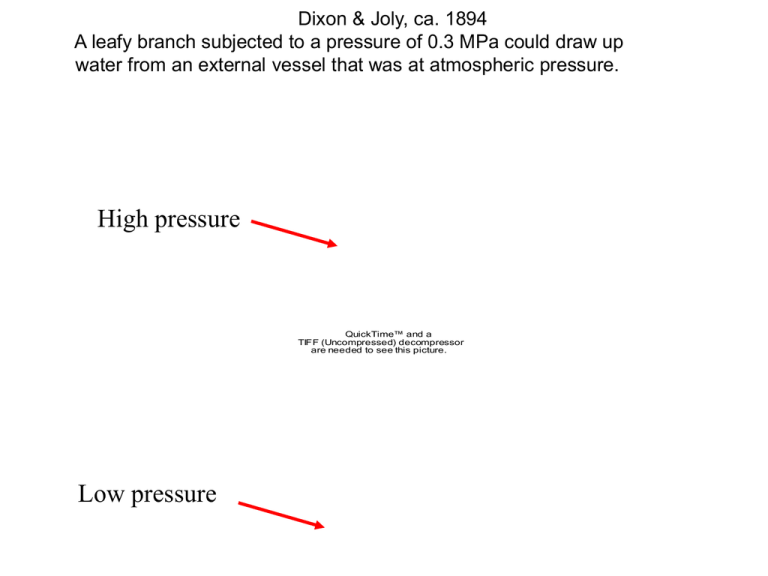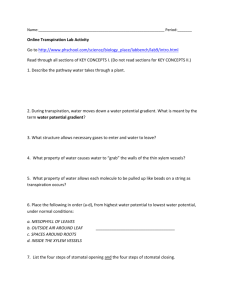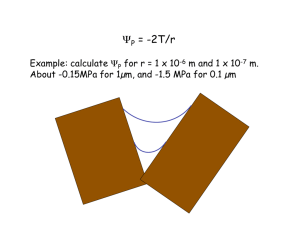Bio426Lecture8Feb6 - NAU jan.ucc.nau.edu web server
advertisement

Dixon & Joly, ca. 1894 A leafy branch subjected to a pressure of 0.3 MPa could draw up water from an external vessel that was at atmospheric pressure. High pressure QuickTime™ and a TIFF (Uncompressed) decompressor are needed to see this picture. Low pressure Putting it all together A model for water movement through the plant. The Cohesion-Tension (CT) Model of xylem transport (dates to Dixon and Joly, 1896) The CT is the most widely accepted model of water transport through the xylem (read the web essay!) 1. A negative pressure or tension is generated in leaf cell walls by evaporation (transpiration). 2. The cohesive property of water means this tension is transmitted to water in adjacent xylem and throughout the plant to the roots and soil. The negative pressure (tension) in the xylem can be measured indirectly with a Scholander pressure “bomb”. QuickTime™ and a TIFF (Uncompressed) decompressor are needed to see this picture. Cohesion-Tension Theory of water transport (Web Essay 4.2) Essential elements 1. Water within the whole plant forms a continuous network of liquid columns from the absorbing surfaces of roots to the evaporating surfaces. 2. This hydraulic continuity transfers instantaneously the variations of tensions or pressure throughout the plant. 3. Hydraulic continuity is highly dependent on the tensile strength of water. 4. The driving force for water movement in the system is generated by surface tension of the menisci of water at the evaporating surfaces within leaves. 5. In this way, transpiration establishes gradients of negative pressure or tension along the pathway in transpiring plants. This causes an inflow of water from the soil to the transpiring surfaces. 6. Due to the fact that transpiration "pulls" the sap from the soil to the leaves, water in the xylem is in a metastable state of tension. In this state, the water column is susceptible to cavitation, (i.e., to the appearance of a vapor phase within the liquid phase). Water relations of tall trees Redwood Douglas-fir mountain ash Redwood, Sequoia sempervirens Mountain ash Eucalyptus regnans Victoria, Australia Giant sequoia Sequoiadendron giganteum Xylem pressure decreases with height as predicted by the cohesion-tension model. Gravity rules! slope = -0.0096 ± 0.0007 MPa m-1 R2 ≥ 0.97, p < 0.0001 Predawn Slope expected due to gravity -2.0 -1.8 -1.6 -1.4 -1.2 -1.0 -0.8 -0.6 -0.4 -0.2 dry season midday XPP (MPa) 0.0 Creating known xylem tensions in stem segments using a centrifuge. (Alder et al. 1997) Redwood cavitation threshold ≈ -1.9MPa 100 Lower crown (60 m) Upper crown (110 m) 90 80 n = 6 trees 70 60 % loss of hydraulic conductivity 50 40 30 Minimum native xylem pressure 20 10 0 -10 -10 -8 -6 -4 Xylem pressure, MPa -2 0 Transpiration the diffusion of water vapor from the internal air spaces of leaves out through the stomatal pore. •Hugely important to local and global hydrological cycles. •Moves vast quantities of water from soils back to atmosphere •Influences energy balance via the cooling effect of evaporation (latent heat of vaporization) •How plants regulate transpiration is vital to survival and growth in a desiccating environnment •Transpiration rate (a flux) is a function of the water vapor diffusion gradient (the driving force) and stomatal aperture (the conductance of the pathway). Flux = driving force x conductance The driving force for transpiration is the H2O conc. gradient from inside to outside the leaf. How can we know the [H2O] inside a leaf? How can we know the [H2O] inside a leaf? The air inside leaves is saturated with water vapor. The [H2O] of saturated air is a strong function of temperature. Warmer air can hold more water vapor than cooler air. Fig. 4.11 How can we know the [H2O] of the air outside the leaf? The [H2O] of the air outside the leaf can be measured. Relative humidity expresses the fraction of the saturation water vapor concentration. Relative humidity = [H2O] / [H2O]sat’n * 100% 50% RH at 25 oC 0.5 x 1.28 = 0.64 mol m-3 The water vapor concentration gradient from inside to outside a leaf. Waxy cuticle Leaf boundary layer resistance H2O CO2 Water from soil Leaf interior H2O CO2 Photosynthesis Stomatal resistance Outside air Leaf boundary layer resistance ei Higher [H2O] Water from soil Leaf interior es ea Lower [H2O] Stomatal resistance Outside air Stomatal aperture (stomatal resistance) changes to regulate transpiration rate. Leaf boundary layer resistance ei Higher [H2O] Water from soil Leaf interior es ea Lower [H2O] Stomatal resistance Outside air Leaf boundary layer resistance ei Higher [H2O] Water from soil Leaf interior es ea Lower [H2O] Stomatal resistance Outside air






